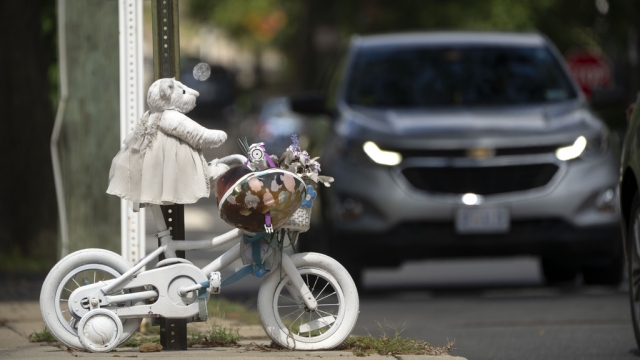For Sidney Ozer, biking down the streets of his hometown of Philadelphia is a family tradition started by his father.
"My father was in charge of all the programs for Fairmount Park, the park system in Philadelphia, and he helped bring some of the bike lanes and bike paths to the city in the 80s," he said, "And I helped organize bike rides through my life."
So, it was no surprise that the bicycling bug also bit his active and athletic son, Samuel.
"Samuel was this bright, happy kid — loved helping people," Ozer said.
That all changed on Father's Day 2020. With his helmet on, Samuel was biking just a mile from his home, when a speeding vehicle struck and killed him.
"He was killed where about 10 other people were recently killed in the past few years as well," Ozer said. "And now, after his death, a recreational bike path was being built and a traffic light is being built."
SEE MORE: Researchers look to AI to reduce pedestrian and bicyclist fatalities
Samuel's death is part of a growing trend in America, where pedestrian and cyclist fatalities are up 60% since 2011 to more than 8,000 last year.
In the past 25 years, the percentage of people who died in road crashes — while inside a vehicle — dropped from 80% of all road deaths to 66%. At the same time, the share of pedestrian and bicyclist deaths climbed sharply – making up 20% of all road deaths in 1997, to now accounting for 34% of all road deaths.
Nicole Brunet is with the nonprofits Bicycle Coalition of Greater Philadelphia and Families for Safe Streets. She says street design is part of the issue.
"If you're somebody in a car, the street is designed perfect for you," Brunet said. "The ideal street is balanced: A street that's built for a pedestrian and a bicyclist, somebody that has mobility issues. We need to think about the most vulnerable user of the road."
Street design is something that also is on the minds of those at the National Association of City Transportation Officials (NACTO) — as are the vehicles that are on those roads.
"A big piece of it is street design and the way our streets are designed to accommodate faster vehicle travel," said Alana Brasier, director of engagement at NACTO. "But also there's a trend with our vehicle design in the U.S. where our vehicles keep getting bigger and bigger and becoming more and more deadly to people walking."
SEE MORE: Lowering your speed by just 5 mph could make the roads safer
Vehicles like pickup trucks and SUVs have become increasingly popular in the U.S. Those vehicles are heavier and higher off the ground and may limit what drivers can see.
"We see, for example, that SUVs and pickups are more likely to be involved in turning crashes at intersections, with pedestrians, compared to cars — and that suggests there might be something going on with their blind spots," said Jessica Cicchino, vice president of research at the Insurance Institute for Highway Safety.
The IIHS is a nonprofit headquartered in Virginia. The institute tests vehicles and issues star ratings based on vehicle safety.
"As of right now, we look at the safety of people inside the vehicle," Cicchino said. "And as of right now, that's what the federal government does as well."
That may be starting to shift, though, as advocates like NACTO push for the federal government to adopt a vehicle rating system that also accounts for how safe a vehicle is for people outside of it.
"It's currently misleading when you buy a vehicle and it's like it's got a five-star safety rating, 'Okay, we're safe in this car,' but you're not aware that you're driving now a very deadly vehicle," NACTO's Brasier said.
SEE MORE: Distraction, speeding, alcohol drive up 2021 traffic deaths
It's something the IIHS is looking into, too.
"We started out by looking at crash avoidance systems that detect pedestrians," Cicchino said. "Last year, we also started testing them in the dark, which is when we see the most number of pedestrian deaths. And so, we're hoping that automakers are going to continue to respond to our ratings to improve their systems, to make them even better."
In a statement to Scripps News, the Alliance for Automotive Innovation, a carmaker industry group, said they support modernizing the vehicle rating system, adding that it's "an important tool to educate the public about vehicle safety. Pedestrian protection is a top priority, so it makes sense for NHTSA to include crash avoidance and crash protection technologies in the program."
Any potential changes, though, come too late for Samuel Ozer. His father, Sidney, said it's why he keeps pushing for improvements to roadway safety and public transportation options — as legacy for his son.
"A kid who loved riding his bike, who loved being with people and loved being with his family," Ozer said. "This is why we fight so hard to make our streets safer."
Trending stories at Scrippsnews.com





